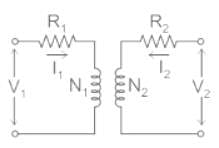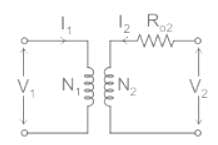Electrical Engineering (EE) Exam > Electrical Engineering (EE) Questions > A 4000 V/2000 V, 60 Hz single phase transform...
Start Learning for Free
A 4000 V/2000 V, 60 Hz single phase transformer has a total impedance of 60 Ω referred to the primary side. The primary and secondary windings have negligible resistances. If the transformer supplies a resistive of 20 Ω, the full load voltage at the secondary side will be
- a)1143 V
- b)1600 V
- c)2000 V
- d)3200 V
Correct answer is option 'A'. Can you explain this answer?
| FREE This question is part of | Download PDF Attempt this Test |
Most Upvoted Answer
A 4000 V/2000 V, 60 Hz single phase transformer has a total impedance ...
Ohms. The primary winding has 200 turns. Calculate the secondary winding turns, the primary current, and the secondary current.
Given data:
Primary voltage (V1) = 4000 V
Secondary voltage (V2) = 2000 V
Frequency (f) = 60 Hz
Total impedance (Z) = 60 ohms
Number of turns in primary winding (N1) = 200
1. Calculate the secondary winding turns (N2):
Voltage ratio = V1/V2 = N1/N2
N2 = N1 * (V2/V1)
N2 = 200 * (2000/4000)
N2 = 100
Therefore, the secondary winding has 100 turns.
2. Calculate the primary current (I1):
Impedance (Z) = V1/I1
I1 = V1/Z
I1 = 4000/60
I1 = 66.67 A
Therefore, the primary current is 66.67 A.
3. Calculate the secondary current (I2):
Current ratio = I1/I2 = N2/N1
I2 = I1 * (N1/N2)
I2 = 66.67 * (200/100)
I2 = 133.33 A
Therefore, the secondary current is 133.33 A.
Given data:
Primary voltage (V1) = 4000 V
Secondary voltage (V2) = 2000 V
Frequency (f) = 60 Hz
Total impedance (Z) = 60 ohms
Number of turns in primary winding (N1) = 200
1. Calculate the secondary winding turns (N2):
Voltage ratio = V1/V2 = N1/N2
N2 = N1 * (V2/V1)
N2 = 200 * (2000/4000)
N2 = 100
Therefore, the secondary winding has 100 turns.
2. Calculate the primary current (I1):
Impedance (Z) = V1/I1
I1 = V1/Z
I1 = 4000/60
I1 = 66.67 A
Therefore, the primary current is 66.67 A.
3. Calculate the secondary current (I2):
Current ratio = I1/I2 = N2/N1
I2 = I1 * (N1/N2)
I2 = 66.67 * (200/100)
I2 = 133.33 A
Therefore, the secondary current is 133.33 A.
Free Test
FREE
| Start Free Test |
Community Answer
A 4000 V/2000 V, 60 Hz single phase transformer has a total impedance ...
Concept:
Consider a two winding single phase transformer as shown below,

N1 = primary winding turns
N2 = secondary winding turns
V1 = primary winding voltage
V2 = secondary winding voltage
I1 = current through the primary winding
I2 = current through the secondary winding
Transformation ratio: It is defined as the ratio of the secondary voltage to the primary voltage. It is denoted by k.

K=N2N1=V2V1=I1I2" tabindex="0">K=N2N1=V2V1=I1I----- (1)Transformer equivalent circuit with respect to secondary can be represented a show below

Where R02 = Effective resistance referred to the secondary side of the transformer.
R02 = R2 + R1' ........ (2)
R1' = Primary winding resistance as referred to the secondary side.
R1' = R1 × k2 ......... (3)
Similarly, the effective resistance referred to the primary side of the transformer is given as,
R01 = R1 + R2'
R2' = Secondary winding resistance as referred to the primary side.
R2' = R2 / k2
Calculation:

Given total impedance of the transformer referred to primary R01 = 60 Ω
Transformation ratio k = V2 / V1 = 2000 / 4000 = 0.5
Total impedance of the transformer referred to secondary when primary and secondary windings have negligible resistances is given as
R02 = R01 × k2
= 60 / 4 = 15 Ω
Apply the voltage division rule to find voltage across the load
VL = 2000 × 20 / (15 + 20)
VL = 1143 V
Attention Electrical Engineering (EE) Students!
To make sure you are not studying endlessly, EduRev has designed Electrical Engineering (EE) study material, with Structured Courses, Videos, & Test Series. Plus get personalized analysis, doubt solving and improvement plans to achieve a great score in Electrical Engineering (EE).

|
Explore Courses for Electrical Engineering (EE) exam
|

|
Similar Electrical Engineering (EE) Doubts
A 4000 V/2000 V, 60 Hz single phase transformer has a total impedance of 60Ω referred to the primary side. The primary and secondary windings have negligible resistances. If the transformer supplies a resistive of 20Ω, the full load voltage at the secondary side will bea)1143 Vb)1600 Vc)2000 Vd)3200 VCorrect answer is option 'A'. Can you explain this answer?
Question Description
A 4000 V/2000 V, 60 Hz single phase transformer has a total impedance of 60Ω referred to the primary side. The primary and secondary windings have negligible resistances. If the transformer supplies a resistive of 20Ω, the full load voltage at the secondary side will bea)1143 Vb)1600 Vc)2000 Vd)3200 VCorrect answer is option 'A'. Can you explain this answer? for Electrical Engineering (EE) 2024 is part of Electrical Engineering (EE) preparation. The Question and answers have been prepared according to the Electrical Engineering (EE) exam syllabus. Information about A 4000 V/2000 V, 60 Hz single phase transformer has a total impedance of 60Ω referred to the primary side. The primary and secondary windings have negligible resistances. If the transformer supplies a resistive of 20Ω, the full load voltage at the secondary side will bea)1143 Vb)1600 Vc)2000 Vd)3200 VCorrect answer is option 'A'. Can you explain this answer? covers all topics & solutions for Electrical Engineering (EE) 2024 Exam. Find important definitions, questions, meanings, examples, exercises and tests below for A 4000 V/2000 V, 60 Hz single phase transformer has a total impedance of 60Ω referred to the primary side. The primary and secondary windings have negligible resistances. If the transformer supplies a resistive of 20Ω, the full load voltage at the secondary side will bea)1143 Vb)1600 Vc)2000 Vd)3200 VCorrect answer is option 'A'. Can you explain this answer?.
A 4000 V/2000 V, 60 Hz single phase transformer has a total impedance of 60Ω referred to the primary side. The primary and secondary windings have negligible resistances. If the transformer supplies a resistive of 20Ω, the full load voltage at the secondary side will bea)1143 Vb)1600 Vc)2000 Vd)3200 VCorrect answer is option 'A'. Can you explain this answer? for Electrical Engineering (EE) 2024 is part of Electrical Engineering (EE) preparation. The Question and answers have been prepared according to the Electrical Engineering (EE) exam syllabus. Information about A 4000 V/2000 V, 60 Hz single phase transformer has a total impedance of 60Ω referred to the primary side. The primary and secondary windings have negligible resistances. If the transformer supplies a resistive of 20Ω, the full load voltage at the secondary side will bea)1143 Vb)1600 Vc)2000 Vd)3200 VCorrect answer is option 'A'. Can you explain this answer? covers all topics & solutions for Electrical Engineering (EE) 2024 Exam. Find important definitions, questions, meanings, examples, exercises and tests below for A 4000 V/2000 V, 60 Hz single phase transformer has a total impedance of 60Ω referred to the primary side. The primary and secondary windings have negligible resistances. If the transformer supplies a resistive of 20Ω, the full load voltage at the secondary side will bea)1143 Vb)1600 Vc)2000 Vd)3200 VCorrect answer is option 'A'. Can you explain this answer?.
Solutions for A 4000 V/2000 V, 60 Hz single phase transformer has a total impedance of 60Ω referred to the primary side. The primary and secondary windings have negligible resistances. If the transformer supplies a resistive of 20Ω, the full load voltage at the secondary side will bea)1143 Vb)1600 Vc)2000 Vd)3200 VCorrect answer is option 'A'. Can you explain this answer? in English & in Hindi are available as part of our courses for Electrical Engineering (EE).
Download more important topics, notes, lectures and mock test series for Electrical Engineering (EE) Exam by signing up for free.
Here you can find the meaning of A 4000 V/2000 V, 60 Hz single phase transformer has a total impedance of 60Ω referred to the primary side. The primary and secondary windings have negligible resistances. If the transformer supplies a resistive of 20Ω, the full load voltage at the secondary side will bea)1143 Vb)1600 Vc)2000 Vd)3200 VCorrect answer is option 'A'. Can you explain this answer? defined & explained in the simplest way possible. Besides giving the explanation of
A 4000 V/2000 V, 60 Hz single phase transformer has a total impedance of 60Ω referred to the primary side. The primary and secondary windings have negligible resistances. If the transformer supplies a resistive of 20Ω, the full load voltage at the secondary side will bea)1143 Vb)1600 Vc)2000 Vd)3200 VCorrect answer is option 'A'. Can you explain this answer?, a detailed solution for A 4000 V/2000 V, 60 Hz single phase transformer has a total impedance of 60Ω referred to the primary side. The primary and secondary windings have negligible resistances. If the transformer supplies a resistive of 20Ω, the full load voltage at the secondary side will bea)1143 Vb)1600 Vc)2000 Vd)3200 VCorrect answer is option 'A'. Can you explain this answer? has been provided alongside types of A 4000 V/2000 V, 60 Hz single phase transformer has a total impedance of 60Ω referred to the primary side. The primary and secondary windings have negligible resistances. If the transformer supplies a resistive of 20Ω, the full load voltage at the secondary side will bea)1143 Vb)1600 Vc)2000 Vd)3200 VCorrect answer is option 'A'. Can you explain this answer? theory, EduRev gives you an
ample number of questions to practice A 4000 V/2000 V, 60 Hz single phase transformer has a total impedance of 60Ω referred to the primary side. The primary and secondary windings have negligible resistances. If the transformer supplies a resistive of 20Ω, the full load voltage at the secondary side will bea)1143 Vb)1600 Vc)2000 Vd)3200 VCorrect answer is option 'A'. Can you explain this answer? tests, examples and also practice Electrical Engineering (EE) tests.

|
Explore Courses for Electrical Engineering (EE) exam
|

|
Suggested Free Tests
Signup for Free!
Signup to see your scores go up within 7 days! Learn & Practice with 1000+ FREE Notes, Videos & Tests.
























